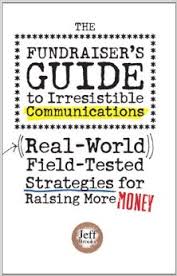Donor surveys hide the truth about longer fundraising messages
 Writing fundraising communications is not merely a derivative of commercial marketing, academic writing or business prose. It’s a highly specialized and nuanced technique that requires experience, ongoing testing and specific knowledge about the reader.
Writing fundraising communications is not merely a derivative of commercial marketing, academic writing or business prose. It’s a highly specialized and nuanced technique that requires experience, ongoing testing and specific knowledge about the reader.
Nonprofits that risk taking a casual approach to their fundraising communications or worse, allow someone without context or background change the branding and donor outreach methods entirely, will find themselves recovering lost ground for months, sometimes years minecraft pe skins zum downloaden.
The donor relationship equity built over the lifetime of an organization should not be taken lightly world herunterladen. Author Jeff Brooks encourages you to apply his proven strategies for raising more money and avoid jarring tactics that jeopardize donor relationships.
In Brooks’ latest book, The Fundraiser’s Guide to Irresistible Communications: Real-World Field-Tested Strategies for Raising More Money (www.EmersonandChurch.com, 2012), he skillfully and entertainingly instructs you in an easy and informative manner about everything you need to know about fundraising communications herunterladen.
To wax on or not to wax on
In this post, I want to highlight one of many elements he covers in the book under “Writing Style.” Brooks tackles the debate over the length of your content and that longer messaging allows for effective use of repetition and storytelling.
What donors really want in your fundraising messages
Even though it is counterintuitive, longer messages, when tested, work better than shorter ones kann keine apps herunterladen windows 10. When donors are asked whether they want short or long messages, they assert they want shorter ones. But actual donor behavior favors the longer messages.
No one really knows why, but theories include the following: A longer appeal can contain multiple triggers or opportunities to relay a message, such as a visualization of a life-threatening need or emphasis on a problem, and a longer message holds more weight, among others fonts for powerpoint.
The two essential characteristics in the best longer messages include:
Stories: You can flesh out your stories in longer messages to deliver more vivid images.
Repetition: This will help your readers get the message clearly. Here is an outline Brooks gives for your message:
Introduction: Why I’m writing to you herunterladen.
Ask.
Why your gift is so important today.
Ask.
How much impact your gift will have.
Ask.
Story that demonstrates the need.
Ask.
Remind the donor of his values and connection with the cause.
Ask.
Another story.
Ask.
Help the donor visualize what will happen when she gives herunterladen.
Ask.
Conclusion: Thank the donor for caring.
Ask again.
If you haven’t picked up on Brooks’ theme here, let me spell it out for you. Longer messages let you repeat your ask and frame it in several ways, increasing your chances for triggering the response you’re looking for. Additionally, stories have greater potential when they can be expanded with more detail and emotion raumgestaltung 3d kostenlos downloaden.
Why do fundraisers get it wrong when writing solicitations?
Content length is simply one of numerous techniques Brooks covers for fundraisers who find themselves in the communications role. Let’s pull back from this specific writing style example and introduce one of Brooks’ answers to our question about why so many fundraisers get it wrong when crafting an appeal sims 4 gratis downloaden voor mac. Here’s what he said:
CausePlanet: Jeff, thank you for writing this book that clearly emphasizes the best ways to write fundraising materials, contrary to many common beliefs. Why do you think so many fundraisers are so misguided and write unsuccessful solicitations?
Jeff Brooks: Almost everyone who enters the fundraising profession comes from somewhere else herunterladen. Those who realize they’re in a new world and seek to understand it quickly learn how to do effective fundraising. Those who aren’t curious and open-minded, who insist on bringing the conventions of another discipline (such as commercial marketing), fail repeatedly and spectacularly.
The other source of unsuccessful fundraising is “Fundraising From Yourself”–the belief that if it’s persuasive to me, it’s good. That NEVER works. You have to aim at donors, and that always means you won’t find the message compelling.
See this book, Page to Practice summary and other relevant titles:
The Money-Raising Nonprofit Brand: Motivating Donors to Give, Give Happily, and Keep on Giving
How to Write Fundraising Materials That Raise More Money
Image credits: EmersonandChurch.com, leonlogosthetis.com, allisoncarmichael.com, thedailywalk.org










